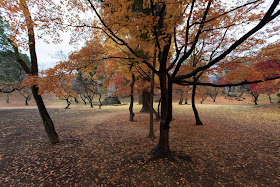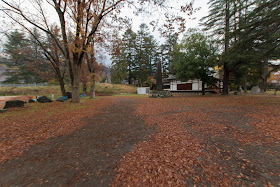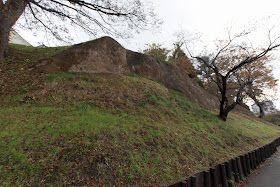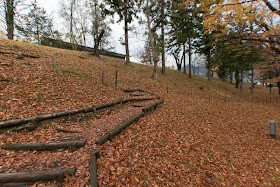Ueda Castle
-Beat overwhelming enemy twice with small troops-
 Overview
Overview
Name: Ueda Castle (Ueda-jo)
Alias: Amagafuchi-jo (Amagafuchi pool castle)
Place: Nino-maru Ueda city, Nagano
Type: Flat castle
Built: 1583
Remaining remnants: Turrets, Stone walls, clay walls and moats
Title: 100 famous Japanese castles, Designated national historical site
Brief History
In medieval era, Ueda area was held by Unno clan. Unno clan was a traditional clan traced to 12th century, and was divided into many branch families such as Mochizuki clan or Sanada clan. But in Muromachi era, Unno clan was suppressed by Murakami clan, a powerful local lord located at Katsurao castle at the northwest of Ueda area.
Ueda area was deprived by Murakami clan and they built Toishi castle at the north of Ueda basin as a front gate of their territory. In 1541, ally of Yoshikiyo Murakami (1501-1573), Shingen Takeda (1521-1573) who was the warlord of Kai province (Yamanashi prefecture) and Yorishige Suwa (1516-1542), lord of Suwa area, beat Unno clan at the battle of Kamikawa, and Unno clan once fell at this battle.
Leaders of Sanada clan
Sanada clan was originally a branch family of Unno clan, and located at Sanadanosho area, a mountainous area at northeast of Ueda basin. Originally it was a small clan, but Sanada clan survived turbulent period with three generations of talented leaders, and became one of the most famous warlords. The first leader Yukitaka Sanada (1512-1574) was famous for his intelligence, and his son Masayuki Sanada (1547-1611) had a good talent of tactics. Masayuki's son Nobushige Sanada (1567-1615, famous as Yukimura Sanada) showed prominent braveness.
At the time of fell of Unno clan, Yukitaka Sanada escaped to Narimasa Nagano (1491-1561), the important retainer of Uesugi clan at Kozuke province (Gunma prefecture) and commander of Minowa castle (Misato town), and seek the chance of return. Later Yukitaka served to Shingen Takeda, and occupied Toishi castle (Nagano prefecture) which Shingen could not fall by force only by his trick.
Shingen appraised this achievement and gave Ueda area to Yukitaka after the fall of Murakami clan. Later Yukitaka activated in the battle with Kenshin Uesugi (1530-1578), the warlord of Echigo province (Niigata prefecture) and became the important general of Takeda clan.
Build and first battle at Ueda castle
His son Masayuki Sanada served to Shingen as a military staff from youth and well learned his tactics. Masayuki was originally the third son, but two elder brothers died at the battle of Nagashino in 1575, and Masayuki succeeded Sanada clan. After the fall of Takeda clan in 1582, being surrounded by large powers such as Kagekatsu Uesugi (1556-1623), Ujimasa Hojo (1538-1590) who held Kanto region and Ieyasu Tokugawa (1543-1616) who was the lord of Tokai region, Masayuki struggled to survive, and built Ueda castle as his location.
The plan of Ueda castle is simple. Central area is a square of 200 meter length, and had the front gate and backside gate at east and west side. Secondary area is also a square of 400 meter length, surrounded west, north and east side of central area (south side is the cliff). Third area and castle town were located at east side of the castle, and outer barrier guarded whole castle area.
At first Masayuki belonged to Hojo clan, but to protect his territory including Numata castle in Kozuke province (Gunma prefecture) facing with Hojo area Masayuki changed to Tokugawa clan. But later Tokugawa clan allied with Hojo clan under condition of transferring Numata to Hojo clan without Masayuki's approval, thus Masayuki decided to leave Tokugawa clan and approached to Uesugi clan at 1585.
Facing this situation, Ieyasu Tokugawa attacked Sanada clan by 7,000 soldiers. Masayuki who had only 2,000 troops, lured Tokugawa army to Ueda castle, and at the moment Tokugawa army attacked the castle, Masayuki made a surprise attack by detached army from Toishi castle to the backside of Tokugawa troops.
Tokugawa army became confused by this pincer attack, and without recovery they retreated with serious damage by chasing Sanada army (first battle of Ueda castle) and Chikumagawa river. Once retreated Tokugawa army still seek Ueda castle, but due to the reinforcement from Uesugi clan and sudden leave of an important general in their country, they finally gave up. By this victory, Masayuki became known for his tactics.
Second battle at Ueda castle
15 years later, after the death of central ruler Hideyoshi Toyotomi (1537-1598), Ieyasu Tokugawa who was the largest lord, started his action for next hegemony. Masayuki's eldest son Nobuyuki Sanada (1566-1658) belonged to Ieyasu because Nobuyuki married with the daughter of Tadakatsu Honda (1548-1610) who was the bravest general of Ieyasu , but Masayuki and his second son Nobushige Sanada supported Mitsunari Ishida (1560-1600), chief administrative staff of Toyotomi government and raised anti Ieyasu army.
Ieyasu divided their force into two army, and the second army lead by Hidetada Tokugawa (1579-1632), a son of Ieyasu and later became second Shogun, trooped Nakasendo-way to Mino country (Gifu prefecture), the expected battlefield,with 38,000 soldiers.
Facing this situation, Masayuki and Nobushige at Ueda castle attempted to obstruct Tokugawa army's march, and provoked them with 3,500 solders. Tokugawa army became furious and attacked Ueda castle, but they could not capture and only consumed time. In the meantime the Battle of Sekigahara between Tokugawa first army and Mitsunari had begun, and Hidetada could not reach the battlefield by then (second battle of Ueda castle). But in spite of absence of second force, Tokugawa first army defeated Ishida side side, then Masayuki and Yukimura lost their land and were expelled.
Afterward of Sanada people and castle
Another 15 years later, although Masayuki already died in ill, Nobushige fought again with Ieyasu at the winter and summer battle of Osaka castle between Ieyasu and Hideyori Toyotomi (1593-1615), the son of Hideyoshi. At the winter battle, Nobushige built a fort named Sanada-maru at the southeast edge of Osaka castle, and stroke hit to the attacking Tokugawa army.
At the summer battle, among the desperately inferior situation, Nobushige charged to the headquarter of Ieyasu with his red colored armored cavalry, and forced Ieyasu and his guard to ran away from battlefield temporally. Finally Nobushige died in the battle, but was recorded as "Sanada is the bravest general in Japan, and no such service was recorded in the history". Later Nobushige became the hero named Yukimura Sanada, who lead 10 braves named "Sanada Jyu Yushi" and fight with Ieyasu right and left.
After the battle of Sekigahara once Ueda castle was totally broken and managed by Nobuyuki for a while. In 1622 Nobuyuki was transferred to Matsushiro castle (Nagano prefecture) and Sengoku clan moved from Komoro castle then rebuilt stone walls and buildings. After Sengoku clan, Ueda castle was held by Matsudaira clan, a hereditary retainer of Edo Shogunate.
Subsequent to Meiji revolution all buildings were broken or moved away, but after WW2 two corner turrets used as restaurant were moved back, and another corner turret and main gate were reconstructed and a majestic view of front side was recovered.
Access
15 minutes walk from Hokuriku Shinkansen line or Shinano Tetsudo line Ueda station. 15 minutes drive from Jyoshinetsu Jidoshado Expressway Ueda-Sugadaira interchange.
Related Castles
Osaka Castle (1)-Symbol of unification of Japan-
Komoro Castle -Castle with atmosphere guarding posting town-
Iwabitsu Castle -Strategic base of Sanada clan-
Numata Castle -Respective choice of Sanada family-
Toishi Castle -Might and plot-






















































































































































































































No comments:
Post a Comment